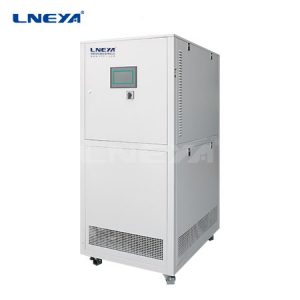Chiller cooling glass reaction tank
Chillers are used to cool glass reaction tanks. It is a common practice, especially in situations where precise temperature control is required during chemical reactions. Chillers can provide stable cooling effects to ensure that the temperature in the reaction tank remains within the required range. The following is a detailed description of how to use chillers to cool glass reaction tanks:
Accurate temperature control:
- •Chillers are generally able to provide high-precision temperature control, usually with a control accuracy of ±1°C or less, and some high-end models can reach ±0.1°C.
- Ensure the temperature of cooling water is stable through PID controller or other advanced temperature control technology.
Wide temperature range:
- Chillers can provide cooling capacity from room temperature to low temperature (such as 0°C to -40°C) according to different needs.
- This wide temperature range makes chillers suitable for a variety of chemical reactions.
Fast cooling capacity:
- Chillers can quickly cool cooling water to the required temperature and are suitable for applications that require fast cooling.
- Fast cooling helps improve experimental efficiency, especially in experiments that require frequent changes in temperature conditions.
Circulating cooling system:
- Chillers are usually equipped with a circulating cooling system, which circulates cooling water between the reaction tank and the chiller to remove heat from the reaction tank.
- The circulation system can ensure uniform cooling and avoid local overcooling or overheating.
Automatic control:
- Chillers usually have automatic control functions, which can automatically adjust the operation of the cooling system according to the temperature in the reaction tank.
- Automatic control helps save labor costs and improve operational efficiency.
Safety measures:
- Chillers usually have a variety of safety measures, such as over-temperature protection, over-pressure protection, and leak detection.
- Safety measures help ensure the safe operation of the equipment and prevent accidents.
Summary Using a chiller to cool a glass reaction tank is an effective way to ensure that chemical reactions are carried out under the required temperature conditions. Through precise temperature control, fast cooling capacity and automated control, the chiller can provide stable cooling effects and improve the reliability and efficiency of experiments. When selecting and using a chiller, it is necessary to determine the most suitable cooling solution based on the specific experimental needs and the characteristics of the reaction tank.
Recommended Products
- MORE
LT -45℃~30℃
Industrial/Laboratory Air ChillerCOOLING TEMP -45℃~30℃Configuration DetailsProductDescriptionCooling MethodData Communication InterfaceAPPLICATION SCENARIOProduct Applicationsrecommend products LOW TEMPERATURE COOLING C…
- MORE
LT 10℃~30℃
Product data downloadConfiguration DetailsProductDescriptionCooling MethodData Communication InterfaceAPPLICATION SCENARIOProduct ApplicationsRecommend products Saving water resources & circulating cooling …
- MORE
LT -25℃~30℃
Low Temperature Air Cooled ChillerIndustry temperature control solutionLT series fixed frequency chillerASET control4.3 version screen100% safety regulations100% helium detectionTemperature range -80°C-30℃Secondary subcooling technologyConfigurat…
loading…
已经是到最后一篇内容了!
 LNEYA Industrial Chillers Manufacturer Supplier -
LNEYA Industrial Chillers Manufacturer Supplier -














